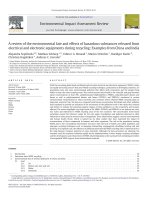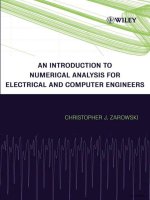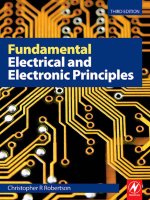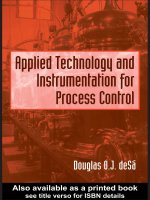EBOOK Electrical and Electronics Measurements and Instrumentation (Prithwiraj Purkait)
Bạn đang xem bản rút gọn của tài liệu. Xem và tải ngay bản đầy đủ của tài liệu tại đây (18.23 MB, 651 trang )
ElectricalandElectronicsMeasurements
andInstrumentation
AbouttheAuthors
PrithwirajPurkaitobtainedhisBEE,MEEandPhDdegreesfromJadavpurUniversity,
Kolkata.HeworkedwithM/sCromptonGreavesLtd,Mumbai,asaDesignEngineerfor
one year. He was involved in post-doctoral research in the University of Queensland,
Australia,during2002-2003,andasVisitingAcademicResearchFellowduring2005and
2007.Presently,heisProfessor,DepartmentofElectricalEngineeringandDean,School
ofEngineering,atHaldiaInstituteofTechnology,Haldia,WestBengal.Hiscurrentareas
of interest include PC/DSP based instruments, motion and industrial process control,
insulation-condition assessment techniques and advanced signal-processing applications.
DrPurkaithaspublishedextensivelyininternationaljournalsandconferenceproceedings
onvarioustopicsrelatedtohisresearchparadigm.
BudhadityaBiswasobtainedhisBEEandMEEfromUniversityofKalyani,Nadiaand
BengalEngineeringandScienceUniversity(BESU),Shibpur,intheyears2002and2006
respectively.HestartedhiscareerasalecturerinHaldiaInstituteofTechnology,Haldia,
in2006.Atpresent,heisworkingasAssistantProfessorattheDepartmentofElectrical
EngineeringinRCCInstituteofInformationTechnology,Kolkata.Hehasbeenteaching
forover6yearsandhisareasofinterestincludepowersystems,especiallythedesignof
microcontroller-based numerical adaptive relay, digital instrumentation, and data
acquisition. He has to his credit publications in international and national conference
proceedingsonvarioustopicsrelatedtohisresearchdomain.
Santanu Das obtained his BEE and MEE from Bengal Engineering and Science
University, Howrah, West Bengal. He has submitted his PhD thesis (in electrical
engineering)toJadavpurUniversity,Kolkata,forevaluation.Earlier,Prof.Dasworkedat
Asansol Engineering College, Asansol, as Lecturer. Presently, he holds the post of
Associate Professor and Head, Department of Electrical Engineering Haldia Institute of
Technology, Haldia. He has published more than 20 research papers in international
journalsandconferenceproceedingsontopicsrelatedtohisresearchdomains.Hiscurrent
fields of research interest include fault diagnosis and condition monitoring of electric
motors,PLCandmicrocontroller-basedmotioncontrol,powerelectronicsanddrives.
ChiranjibKoleyobtainedhisB.TechfromHIT,Haldia,M.TechfromIITDelhiandPhD
from Jadavpur University, Kolkata. He received the EFIP Scholarship in 2001 from the
Government of India. Presently, he is Associate Professor in Department of Electrical
Engineering,NationalInstituteofTechnology,Durgapur,WestBengal.Hiscurrentareas
of interest include signal processing, machine learning, and measurement and
instrumentation.Hehaspublishedextensivelyinnationalandinternationaljournals,and
conferenceproceedingsonvarioustopicsrelatedtohisresearchareas.
ElectricalandElectronics
MeasurementsandInstrumentation
PrithwirajPurkait
Professor
DepartmentofElectricalEngineeringand
Dean,SchoolofEngineering
HaldiaInstituteofTechnology
Haldia,WestBengal
BudhadityaBiswas
AssistantProfessor
DepartmentofElectricalEngineering
RCCInstituteofInformationTechnology
Kolkata,WestBengal
SantanuDas
AssociateProfessor
DepartmentofElectricalEngineering
HaldiaInstituteofTechnology
Haldia,WestBengal
ChiranjibKoley
AssociateProfessor
ElectricalEngineeringDepartment
NationalInstituteofTechnology(NIT)Durgapur
Durgapur,WestBengal
McGrawHillEducation(India)PrivateLimited
PublishedbyMcGrawHillEducation(India)PrivateLimited
P-24,GreenParkExtension,NewDelhi110016
ElectricalandElectronicsMeasurementsandInstrumentation
Copyright©2013,byMcGrawHillEducation(India)PrivateLimited.
Nopartofthispublicationmaybereproducedordistributedinanyformorbyanymeans,electronic,mechanical,
photocopying,recording,orotherwiseorstoredinadatabaseorretrievalsystemwithoutthepriorwrittenpermissionof
thepublishers.Theprogramlisting(ifany)maybeentered,storedandexecutedinacomputersystem,buttheymaynot
bereproducedforpublication.
ThiseditioncanbeexportedfromIndiaonlybythepublishers,
McGrawHillEducation(India)PrivateLimited.
ISBN(13):978-1-25-902959-2
ISBN(10):1-25-902959-X
VicePresidentandManagingDirector:AjayShukla
Head—HigherEducationPublishingandMarketing:VibhaMahajan
PublishingManager—SEM&Tech.Ed:ShaliniJha
EditorialExecutive:KoyelGhosh
Manager—ProductionSystems:SatinderSBaveja
AssistantManager—EditorialServices:SohiniMukherjee
SeniorProductionManager:PLPandita
AssistantGeneralManager(Marketing)—HigherEducation:VijaySarathi
SeniorProductSpecialist:TinaJajoriya
SeniorGraphicDesigner—Cover:MeenuRaghav
GeneralManager—Production:RajenderPGhansela
Manager—Production:RejiKumar
InformationcontainedinthisworkhasbeenobtainedbyMcGrawHillEducation(India),fromsourcesbelievedto
bereliable.However,neitherMcGrawHillEducation(India)noritsauthorsguaranteetheaccuracyorcompleteness
ofanyinformationpublishedherein,andneitherMcGrawHillEducation(India)noritsauthorsshallberesponsible
for any errors, omissions, or damages arising out of use of this information. This work is published with the
understandingthatMcGrawHillEducation(India)anditsauthorsaresupplyinginformationbutarenotattempting
torenderengineeringorotherprofessionalservices.Ifsuchservicesarerequired,theassistanceofanappropriate
professionalshouldbesought.
TypesetatText-o-Graphics,B-1/56,AravaliApartment,Sector-34,Noida201301,andprintedat
CoverPrinter:
Contents
Preface
GuidedTour
1.ConceptofMeasurementSystems
1.1Introduction
1.2FundamentalandDerivedUnits
1.3StandardsandtheirClassifications
1.4MethodsofMeasurement
1.5MeasurementSystemanditsElements
1.6ClassificationofInstruments
1.7DefinitionsofSomeStaticCharacteristics
1.8MeasurementofErrors
1.9LoadingEffects
Exercise
2.AnalogMeters
2.1Introduction
2.2ClassificationofAnalogInstruments
2.3PrincipleofOperation
2.4OperatingTorques
2.5ConstructionalDetails
2.6PermanentMagnetMovingCoilInstrument
2.7ExtensionofRangeofPMMCInstruments
2.8Moving-IronInstruments
2.9Electrodynamometer-TypeInstruments
2.10ElectrostaticInstruments
2.11Induction-typeInstruments
2.12ElectrothermalInstruments
2.13Rectifier-typeInstruments
2.14TruermsVoltmeter
2.15ComparisonbetweenDifferentTypesofInstruments
Exercise
3.InstrumentTransformers
3.1Introduction
3.2AdvantagesofInstrumentTransformers
3.3CurrentTransformers(CT)
3.4TheoryofCurrentTransformers
3.5ErrorsIntroducedbyCurrentTransformers
3.6OperationalCharacteristicsofCurrentTransformers
3.7DesignandConstructionalFeaturesofCurrentTransformers
3.8PrecautionsinUseofCurrentTransformer
3.9PotentialTransformers(PT)
3.10TheoryofPotentialTransformers
3.11ErrorsIntroducedbyPotentialTransformers
3.12OperationalCharacteristicsofPotentialTransformers
3.13DesignandConstructionalFeaturesofPotentialTransformers
3.14DifferencesbetweenCTandPT
Exercise
4.MeasurementofResistance
4.1Introduction
4.2MeasurementofMediumResistances
4.3MeasurementofLowResistances
4.4MeasurementofHighResistances
4.5LocalisationofCableFaults
Exercise
5.Potentiometers
5.1Introduction
5.2ABasicdcPotentiometer
5.3Crompton’sdcPotentiometers
5.4ApplicationsofdcPotentiometers
5.5ACPotentiometers
5.6ClassificationofACPotentiometers
5.7AdvantagesandDisadvantagesofACPotentiometers
5.8ApplicationsofACPotentiometer
Exercise
6.ACBridges
6.1Introduction
6.2SourcesandDetectorsinACBridges
6.3GeneralBalanceEquationforFour-ArmBridge
6.4MeasurementofSelf-Inductance
6.5MeasurementofCapacitance
6.6MeasurementofFrequency
6.7WagnerEarthingDevice
Exercise
7.PowerMeasurement
7.1Introduction
7.2PowerMeasurementindcCircuits
7.3PowerMeasurementinacCircuits
7.4ElectrodynamometerTypeWattmeter
7.5Induction-typeWattmeter
7.6PowerMeasurementinPolyphaseSystems
7.7PowerMeasurementinThree-PhaseSystems
7.8ReactivePowerMeasurements
7.9PowerMeasurementwithInstrumentTransformers
Exercise
8.MeasurementofEnergy
8.1Introduction
8.2Single-PhaseInduction-typeEnergyMeter
8.3ErrorsinInduction-typeEnergyMetersandTheirCompensation
8.4TestingofEnergyMeters
Exercise
9.CathodeRayOscilloscope
9.1Introduction
9.2BlockDiagramofaCathodeRayTube(CRT)
9.3ElectrostaticDeflection
9.4TimeBaseGenerator
9.5VerticalInputandSweepGeneratorSignalSynchronisation
9.6MeasurementofElectricalQuantitieswithCRO
9.7MeasurementofVoltageandCurrent
9.8MeasurementofFrequency
9.9MeasurementofPhaseDifference
9.10SamplingOscilloscope
9.11StorageOscilloscope
9.12Multi-InputOscilloscopes
9.13FrequencyLimitationofCRO
Exercise
10.ElectronicInstruments
10.1Introduction
10.2MeritsandDemeritsofDigitalInstrumentsoverAnalogOnes
10.3PerformanceCharacteristicsofDigitalMeters
10.4DigitalMultimeter
10.5DigitalFrequencyMeter
10.6DigitalVoltmeters(DVMs)
10.7SignalGenerators
Exercise
11.SensorsandTransducers
11.1Introduction
11.2ElectricalTransducers
11.3LinearVariabledifferentialTransformer(LVDT)
11.4StrainGauges
11.5ElectromagneticFlowMeter
11.6TemperatureTransducers
11.7PressureMeasurement
Exercise
12.MagneticMeasurements
12.1Introduction
12.2TypesofMagneticMeasurements
12.3TheBallisticGalvanometer
12.4Fluxmeter
12.5UsesofBallisticGalvanometerandFluxmeter
12.6MeasurementofFluxDensity
12.7MeasurementofMagnetisingForce(H)
12.8DeterminationofMagnetisingCurve
12.9DeterminationofHysteresisLoop
12.10TestingofSpecimensintheFormofRodsorBars
12.11Permeameters
12.12MeasurementofMagneticLeakage
12.13MagneticTestingwithAlternatingCurrent
12.14BridgeandacPotentiometerMethods
12.15MagneticShielding
Exercise
13.SignalGeneratorsandAnalysers
13.1Introduction
13.2Oscillators
13.3HartleyOscillator
13.4ColpittsOscillators
13.5TheRCOscillator
13.6WienBridgeOscillators
13.7CrystalOscillators
13.8PierceOscillator
13.9MicroprocessorClocks
13.10SquareWaveandPulseGenerators
13.11TriangularWaveGenerator
13.12Sine-WaveGenerator
13.13FunctionGenerators
13.14RFSignalGenerator
13.15SweepFrequencyGenerator
13.16WaveAnalyser
13.17HarmonicDistortionAnalysers
13.18SpectrumAnalyser
Exercise
14.DataAcquisitionSystem
14.1Introduction
14.2BasicComponentsofDataAcquisitionSystems
14.3ComponentsofaTypicalPC-basedDataAcquisitionSystem
14.4AnalogInputSubsystem
14.5AnalogOutputSubsystem
14.6DigitalInputandOutputSubsystem
14.7IEEE488Interface
Exercise
15.Recording,StorageandDisplayDevices
15.1Introduction
15.2AnalogRecorders
15.3DigitalRecorders
15.4DisplaySystem
Exercise
16.ProgrammableLogicControllers
16.1Introduction
16.2AdvantagesofPLCs
16.3TheControlProgram
16.4FunctionofeachPartinPLC
16.5HardwareofPLC
16.6SystemAddressing
16.7PLCOperationandProgramScan
16.8ImplementationofControlProgramsinPLC
16.9MoreinLadderLogic
Exercise
17.MicrowaveandRFMeasurement
17.1IntroductiontoRFandWirelessCommunicationSystem
17.2RadioFrequencyandMicrowaveSpectralAnalysis
17.3RadioFrequencySpectrumAnalyser
17.4RFScalarandVectorNetworkAnalyser
17.5Modulation
17.6CommunicationSystems
17.7RFVoltageandPowerMeasurement
Exercise
18.FibreOpticMeasurements
18.1Introduction
18.2HowdoesanOpticalFibreWork?
18.3SourcesandDetectors
18.4FibreOpticPowerMeasurement
Exercise
AppendixATableofSIUnits
AppendixBNumberSystems
AppendixCWestenFrequencyMeter
SolvedSampleQuestionPapers
Index
Preface
Overview
This book can be used as a textbook for the course in electrical and electronics
measurementsandinstrumentation.Itpresentsacomprehensivetreatmentofthesubjectof
electrical and electronics measurements and instrumentation as taught to the
undergraduatestudentsofB.Tech/BEinElectricalEngineering,ElectricalandElectronics
Engineering, Instrumentation Engineering, and allied branches. The book thus aims at
maintaining balance between these diverse fields of engineering disciplines by drawing
examplesfromvariousapplications.Theprerequisiteonthepartofthereaderisthatheor
sheshouldhavehadintroductorycoursesonlinearalgebra,basiccalculus,vector/phasor
analysis, transform theory, circuit analysis and elementary mechanics. For the students’
interest,appendicesonnumbersystemsandunitconversionsareaddedattheend.
Aim
While conceptualising the text, the authors felt that the scope and method of treatment
could, with advantage, be augmented to suit the requirements of various branches of
engineering.Owingtotherapidadvancementstakingplaceinmodernelectricalandallied
industries, and their interconnection with power systems, the subject of electrical and
electronicsmeasurementsisgaininganever-increasingimportance.
AbouttheBook
As a subject of study, electrical measurement is one of the more traditional fields of
electrical and allied engineering disciplines. However, with progress in technology and
manufacturingexpertise,measurementsofphysicalparametershavegainednewheightsin
termsofstate-of-the-artconceptsandtechnologies.Thisbookaimsatbridgingtraditional
concepts with modern technologies of electrical and electronics measurements and
instrumentation.
The text is designed for an undergraduate course in electrical and electronics
measurements. Since the basic concepts cut across disciplines—such as electrical,
mechanical, electronics, instrumentation and control engineering—this book presents a
proper balance between theoretical and analytical approach, as well as practical
illustrations along with computational approach for solving various kinds of numerical
problems. Some of the subjects dealt with are essentially mathematical in nature, and
cannot be treated otherwise, but the mathematics throughout the book has been kept as
simpleaspossiblesothatitisfollowedeasilybymostreaders.Thetheoryofmostofthe
measurement techniques and measuring instruments has been dealt with in sufficient
detail,butinmostcasesconciseformshavebeenusedforsuchtheoreticaldiscussions,so
that readers may skip them, if desired, and consider only the resulting expressions.
Photographs of real systems have been used in places where schematic representation
neededtobeaugmented.
Themainthemeofthisbookhasbeentocatertoundergraduatestudents.Alltopicsin
differentchaptershavebeendevelopedwithampleandadequatedetailwithoutsubjecting
students to unwanted complicacies. As a textbook, this contribution is expected to help
students not only in building up their knowledge of physical concepts of the systems
described,butalsoasareadyandconcisereference.
SalientFeatures
Coveragebridgestraditionalconceptswithmoderntechnologiesinthesubjectarea
Comprehensivediscussionsonelectronicmeasurementsystemsandrelated
componentsincludinganalysers,dataacquisitionsystems,etc.
Special-purposemeasurementsandapplicationssuchasmagneticmeasurements
andfibreopticmeasurementscovered
DedicatedchapteronSensorsandTransducers
Inclusionofreal-lifephotographstoaugmentschematicdiagramswherever
necessary
Solvedquestionpapersfrom9universities
Richpedagogy
•Illustrations:400
•SolvedExamples:100
•Objective-typeQuestions:236
•Short-Answer-Type
Questions:164
•Long-Answer-TypeQuestions:119
ChapterOrganisation
The entire text is organised into 18 chapters. Chapter organisation has been primarily
based on the electrical and electronic measurement syllabi in BE/B.Tech undergraduate
coursesofuniversitiesaroundthecountry.Theoutlineofthebookcanbeorganisedinthe
followingfourmajorparts:
1. Generalconceptsofmeasurement
2. Electricalmeasurementtechniquesandclassicalmeasuringinstruments
3. Modernmeasurementtechniquesandinstruments
4. Briefconceptsofsensorsandtransducers
5. Electronicmeasurementsystemsandrelatedcomponentsincludingsignalgenerators,
analysers, data acquisition systems, storage and display devices and programmable
logiccontrollers
6. Applications of the concepts of electrical and electronic measurement systems in
special-purpose measurements including magnetic measurements, fibre optic
measurements,RFandmicrowavemeasurements.
Withinthisframework,amorein-depthbreakdowncanbeobtainedfromthetableof
contents.Detailinginthetableofcontentwillbeusefulfortheinstructorsandstudentsto
selectpartsofthetextthatmightbeappropriateforthespecificneedathand.Inplaces
whereillustrationsandexplanationshavebeensummarised,theadequatelistofreference
attheendwillenableenthusiasticreaderstoprobefurther.Thefluidflowoftextdealing
withdifferenttopicshasbeenwellthoughtoutbytheauthorswhohaveseveralyearsof
experience in teaching the subject directly to undergraduate students. Illustrations,
examples,questions,highlights,exercises,numericalproblemsareextremelyrelevantand
appropriate for students as well as instructors. The main strength of the book thus is its
strong focus towards students’ readability and understanding with the scope for
independentstudyandproblem-solvingskilldevelopment.Theauthorsareconfidentthat
thedepthofthisbookhasbeenjudiciouslydevelopedsothatstudentsnotonlytreatthisas
atextbook,but,inaddition,canalsogatherenoughpracticalandtheoreticalknowledgeto
appearinnational-levelcompetitiveexaminationsandinterviews.
WebSupplements
The text is supplemented with an exhaustive Online Learning Center, which can be
accessedat />ItcontainsPowerPointlectureslidesandtheSolutionManual.
Acknowledgements
Wearethankfultoallthosewhohavedirectlyorindirectlyhelpedusinbringingoutthis
book. First, we would like to thank the reviewers who through various instances have
providedcommentsthathaveshapedthisbook.Theirnamesaregivenbelow:
NileshChaurasia
SriVaishnavInstituteofTechnologyandScience,
Indore,MadhyaPradesh
SaurabhBasu
GLAUniversity,Mathura,UttarPradesh
PraveenTiwari
IMITCollege,Meerut,UttarPradesh
SBLSeksena
NationalInstituteofTechnology(NIT)Jamshedpur,
Jharkhand
SuvenduNaryanMishra
VeerSurendraSaiUniversityofTechnology
(VSSUT),Burla,Odisha
SamirEkbote
DattaMegheCollegeofEngineering,NaviMumbai,
Mumbai,Maharashtra
VGSarode
XavierInstituteofEngineering,Mumbai,
Maharashtra
CDKapse
WatmullInstituteofEngineeringandComputer
Technology,Mumbai,Maharashtra
RubanN
VelloreInstituteofTechnology(VIT)University,
Vellore,TamilNadu
SubhashKrishnamoorthy
NationalInstituteofTechnology(NIT),Calicut,
TamilNadu
RSVaradhan
ICFAIInstituteofTechnology&Science,Hyderabad,
AndhraPradesh
KESrinivasMurthy
SriVenkateswaraInstituteofTechnology,
Ananthapur,AndhraPradesh
CHMadhuri
SriInduCollegeofEngineering,Hyderabad,Andhra
Pradesh
ThanksarealsoduetothestaffatMcGrawHillEducation(India)forbringingoutthis
bookinsuchashorttime.Finally,wewouldliketothankourrespectivefamilymembers
whose patience and love was a source of encouragement during the preparation of this
manuscript.
Suggestionsforimprovementswillalwaysbewelcome.
PRITHWIRAJPURKAIT
BUDHADITYABISWAS
SANTANUDAS
CHIRANJIBKOLEY
Publisher’sNote
Doyouhaveanyfurtherrequestorasuggestion?Wearealwaysopentonewideas(the
bestonescomefromyou!).Youmaysendyourcommentsto
Piracy-relatedissuesmayalsobereported!
INTRODUCTION
1.1
Measurement is the act, or the result, of a quantitative comparison between a given
quantityandaquantityofthesamekindchosenasaunit.Theresultofthemeasurementis
expressed by a pointer deflection over a predefined scale or a number representing the
ratiobetweentheunknownquantityandthestandard.Astandardisdefinedasthephysical
personification of the unit of measurement or its submultiple or multiple values. The
device or instrument used for comparing the unknown quantity with the unit of
measurement or a standard quantity is called a measuringinstrument. The value of the
unknownquantitycanbemeasuredbydirectorindirectmethods.Indirectmeasurement
methods, the unknown quantity is measured directly instead of comparing it with a
standard.Examplesofdirectmeasurementarecurrentbyammeter,voltagebyvoltmeter,
resistance by ohmmeter, power by wattmeter, etc. In indirect measurement methods, the
value of the unknown quantity is determined by measuring the functionally related
quantityandcalculatingthedesiredquantityratherthanmeasuringitdirectly.Supposethe
resistanceas(R)ofaconductorcanbemeasuredbymeasuringthevoltagedropacrossthe
conductor and dividing the voltage (V) by the current (I) through the conductors, by
Ohm’s
FUNDAMENTALANDDERIVEDUNITS
1.2
At the time of measuring a physical quantity, we must express the magnitude of that
quantityintermsofaunitandanumericalmultiplier,i.e.,
Magnitudeofaphysicalquantity=(Numericalratio)×(Unit)
Thenumericalratioisthenumberoftimestheunitoccursinanygivenamountofthe
samequantityand,therefore,iscalledthenumberofmeasures.Thenumericalratiomay
becallednumericalmultiplier.However,inmeasurements,weareconcernedwithalarge
number of quantities which are related to each other, through established physical
equations, and therefore the choice of size of units of these quantities cannot be done
arbitrarily and independently. In this way, we can avoid the use of awkward numerical
constants when we express a quantity of one kind which has been derived from
measurementofanotherquantity.
Inscienceandengineering,twokindsofunitsareused:
•Fundamentalunits
•Derivedunits
Thefundamentalunitsinmechanicsaremeasuresoflength,massandtime.Thesizesof
the fundamental units, whether foot or metre, pound or kilogram, second or hour are
arbitraryandcanbeselectedtofitacertainsetofcircumstances.Sincelength,massand
time are fundamental to most other physical quantities besides those in mechanics, they
are called the primary fundamental units. Measures of certain physical quantities in the
thermal,electricalandilluminationdisciplinesarealsorepresentedbyfundamentalunits.
These units are used only when these particular classes are involved, and they may
thereforebedefinedasauxiliaryfundamentalunits.
All other units which can be expressed in terms of the fundamental units are called
derivedunits.Everyderivedunitoriginatesfromsomephysicallawdefiningthatunit.For
example,thearea(A)ofarectangleisproportionaltoitslength(l)andbreadth(b),orA=
lb. if the metre has been chosen as the unit of length then the area of a rectangle of 5
metresby7metresis35m2.Notethatthenumbersofmeasurearemultipliedaswellas
theunits.Thederivedunitforarea(A)isthenthemetresquare(m2).
Aderivedunitisrecognizedbyitsdimensions,whichcanbedefinedasthecomplete
algebraicformulaforthederivedunit.Thedimensionalsymbolsforthefundamentalunits
of length, mass and time are L, M and T respectively. The dimensional symbol for the
derivedunitofareaisL2andthatforvolumeisL3.Thedimensionalsymbolfortheunit
of force is MLT , which follows from the defining equation for force. The dimensional
formulasofthederivedunitsareparticularlyusefulforconvertingunitsfromonesystem
to another. For convenience, some derived units have been given new names. For
example,thederivedunitofforceintheSIsystemiscalledthenewton(N),insteadofthe
dimensionallycorrectkg-m/s2.
STANDARDSANDTHEIRCLASSIFICATIONS
1.3
Astandardofmeasurementisaphysicalrepresentationofaunitofmeasurement.Aunitis
realisedbyreferencetoanarbitrarymaterialstandardortonaturalphenomenaincluding
physical and atomic constants. The term ‘standard’ is applied to a piece of equipment
havingaknownmeasureofphysicalquantity.Forexample,thefundamentalunitofmass
intheSIsystemisthekilogram,definedasthemassofthecubicdecimetreofwateratits
temperatureofmaximumof4°C.Thisunitofmassisrepresentedbyamaterialstandard;
themassoftheinternationalprototypekilogramconsistingofaplatinum–iridiumhollow
cylinder. This unit is preserved at the International Bureau of Weights and Measures at
Sevres, near Paris, and is the material representation of the kilogram. Similar standards
havebeendevelopedforotherunitsofmeasurement,includingfundamentalunitsaswell
asforsomeofthederivedmechanicalandelectricalunits.
Theclassificationsofstandardsare
1.Internationalstandards
2.Primarystandards
3.Secondarystandards
4.Workingstandards
5.Currentstandards
6.Voltagestandards
7.Resistancestandards
8.Capacitancestandards
9.Timeandfrequencystandards
1.3.1InternationalStandards
Theinternationalstandardsaredefinedbyinternationalagreement.Theyrepresentcertain
units of measurement to the closest possible accuracy that production and measurement
technology allow. International standards are periodically checked and evaluated by
absolutemeasurementsintermsofthefundamentalunits.Thesestandardsaremaintained
attheInternationalBureauofWeightsandMeasuresandarenotavailabletotheordinary
userofmeasuringinstrumentsforpurposesofcomparisonorcalibration.Table1.1shows
basicSIUnits,QuantitiesandSymbols.
Table1.1BasicQuantities,SIUnitsandSymbols
1.3.2PrimaryStandards
Theprimarystandardsaremaintainedbynationalstandardslaboratoriesindifferentplaces
oftheworld.TheNationalBureauofStandards(NBS)inWashingtonisresponsiblefor
maintenance of the primary standards in North America. Other national laboratories
include the National Physical Laboratory (NPL) in Great Britain and the oldest in the
world, the Physikalisch Technische Reichsanstalt in Germany. The primary standards,
again representing the fundamental units and some of the derived mechanical and
electrical units, are independently calibrated by absolute measurements at each of the
national laboratories. The results of these measurements are compared with each other,
leading to a world average figure for the primary standard. Primary standards are not
availableforuseoutsidethenationallaboratories.Oneofthemainfunctionsofprimary
standardsistheverificationandcalibrationofsecondarystandards.
1.3.3SecondaryStandards
Secondarystandardsarethebasicreferencestandardsusedintheindustrialmeasurement
laboratories. These standards are maintained by the particular involved industry and are
checked locally against other reference standards in the area. The responsibility for
maintenanceandcalibrationrestsentirelywiththeindustriallaboratoryitself.Secondary
standards are generally sent to the national standards laboratory on a periodic basis for
calibration and comparison against the primary standards. They are then returned to the
industrial user with a certification of their measured value in terms of the primary
standard.
1.3.4WorkingStandards
Workingstandardsaretheprincipletoolsofameasurementlaboratory.Theyareusedto
check and calibrate general laboratory instruments for accuracy and performance or to
performcomparisonmeasurementsinindustrialapplications.Amanufacturerofprecision
resistances,forexample,mayuseastandardresistorinthequalitycontroldepartmentof
his plant to check his testing equipment. In this case, the manufacturer verifies that his
measurementsetupperformswithintherequiredlimitsofaccuracy.
1.3.5CurrentStandard
Thefundamentalunitofelectriccurrent(Ampere)isdefinedbytheInternationalSystem
of Units (SI) as the constant current which, if maintained in two straight parallel
conductorsofinfinitelengthandnegligiblecircularcrosssectionplaced1meterapartin
vacuum,willproducebetweentheseconductorsaforceequalto2×10-7newtonpermeter
length.Earlymeasurementsoftheabsolutevalueoftheampereweremadewithacurrent
balancewhichmeasuredtheforcebetweentwoparallelconductors.Thesemeasurements
were rather crude and the need was felt to produce a more practical and reproducible
standard for the national laboratories. By international agreement, the value of the
internationalamperewasbasedontheelectrolyticdepositionofsilverfromasilvernitrate
solution.Theinternationalamperewasthendefinedasthatcurrentwhichdepositssilver
at the rate of 1.118 mg/s from a standard silver nitrate solution. Difficulties were
encountered in the exact measurement of the deposited silver and slight discrepancies
existed between measurements made independently by the various National Standard
Laboratories.Later,theinternationalamperewassupersededbytheabsoluteampereand
itisnowthefundamentalunitofelectriccurrentintheSIandisuniversallyacceptedby
internationalagreement.
1.3.6VoltageStandard
Inearlytimes,thestandardvoltwasbasedonanelectrochemicalcellcalledthesaturated
standardcellorsimplystandardcell.Thesaturatedcellhastemperaturedependence,and
the output voltage changes about -40 µV/°C from the nominal of 1.01858 volt. The
standard cell suffers from this temperature dependence and also from the fact that the
voltageisafunctionofachemicalreactionandnotrelateddirectlytoanyotherphysical
constants.In1962,basedontheworkofBrianJosephson,anewstandardforthevoltwas
introduced. A thin-film junction is cooled to nearly absolute zero and irradiated with
microwave energy. A voltage is developed across the junction, which is related to the
irradiatingfrequencybythefollowingrelationship:
where,h=Planck’sconstant=6.63×10-34J-s
e=chargeofanelectron=1.602×10-19C
f=frequencyofthemicrowaveirradiation
In Eq. (1.1), the irradiation frequency is the only variable, thus the standard volt is
related to the standard of time/frequency. When the microwave irradiating frequency is
lockedtoanatomicclockorabroadcastfrequencystandardsuchasWWVB,theaccuracy
ofthestandardvolt,includingallofthesysteminaccuracies,isonepartin108.
The major method of transferring the volt from the standard based on the Josephson
junction to secondary standards used for calibration of the standard cell. This device is
called the normal or saturated Weston cell. The Weston cell has a positive electrode of
mercuryandanegativeelectrodeofcadmiumamalgam(10%cadmium).Theelectrolyte
is a solution of cadmium sulfate. These components are placed in an H-shaped glass
containerasshowninFigure1.1.
Figure1.1Standardcellofemfof1.0183voltat20°C(Courtesy,physics.kenyon.edu)
1.3.7ResistanceStandard
IntheSIsystem,theabsolutevalueofohmisdefinedintermsofthefundamentalunitsof
length, mass and time. The absolute measurement of the ohm is carried out by the
InternationalBureauofWeightsandMeasuresinSevresandalsobythenationalstandard
laboratories,whichpreserveagroupofprimaryresistancestandards.TheNBSmaintains
a group of those primary standards (1 ohm standard resistors) which are periodically
checkedagainsteachotherandareoccasionallyverifiedbyabsolutemeasurements.The
standardresistorisacoilofwireofsomealloylikemanganinwhichhasahighelectrical
resistivityandalowtemperaturecoefficientofresistance.Theresistancecoilismounted
in a double walled sealed container as shown in Figure 1.2 to prevent changes in









